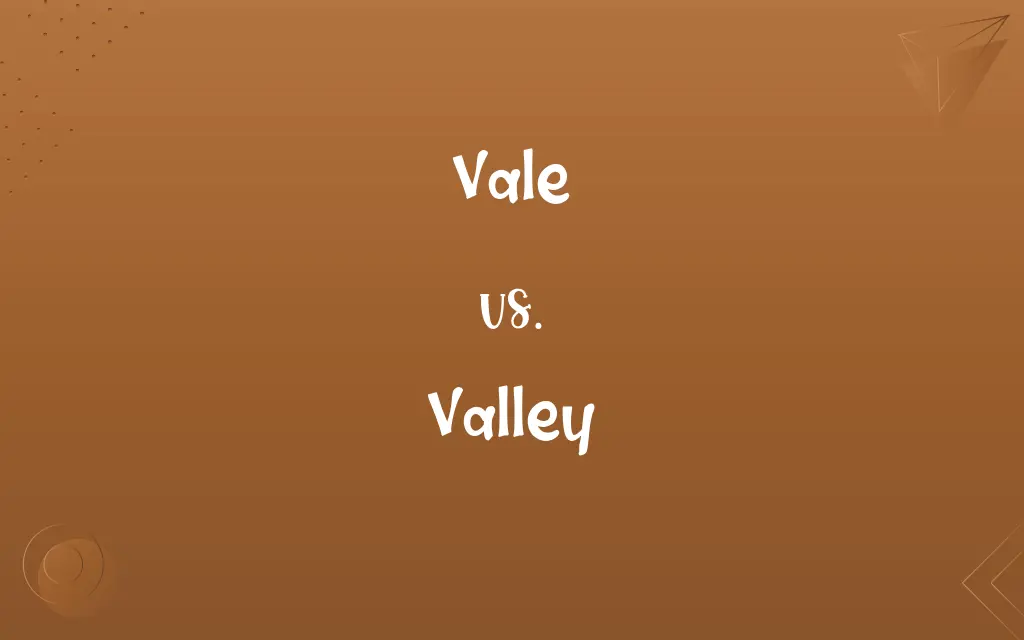Vale vs. Valley: Know the Difference

By Shumaila Saeed & Hifza Nasir || Updated on March 3, 2024
A vale is a poetic or literary term for a valley, often implying a smaller or more picturesque landscape, while a valley is a broad term for any low area between hills or mountains, typically with a river or stream running through it.

Key Differences
The term "vale" is used predominantly in poetic and literary contexts to evoke imagery of serene, idyllic landscapes nestled between hills or mountains. Valleys, on the other hand, are defined in geographical terms as extended low areas between higher ground, often formed by water erosion or glacial activity.
Hifza Nasir
Mar 03, 2024
Vales are typically described as more picturesque or romanticized landscapes, suggesting a peaceful and untouched quality. Valleys can vary greatly in size, shape, and function, ranging from vast agricultural lands to rugged mountain valleys shaped by rivers or glaciers.
Shumaila Saeed
Mar 03, 2024
The use of "vale" often carries connotations of fertility, beauty, and tranquility, idealizing the landscape as a retreat from the harsher realities of life. Valleys are recognized for their ecological and geographical significance, providing habitats for diverse species and pathways for water flow.
Shumaila Saeed
Mar 03, 2024
Literature and poetry use "vale" to symbolize shelter, solitude, or a connection to nature, emphasizing the emotional or spiritual responses such landscapes evoke. The scientific study of valleys focuses on their formation, evolution, and role in the earth’s topography and water cycles.
Dua Fatima
Mar 03, 2024
While "vale" and "valley" can refer to similar physical landscapes, the choice of word reflects the speaker's or writer's intention—whether to convey a technical description or to imbue the scene with a sense of beauty and peace.
Shumaila Saeed
Mar 03, 2024
ADVERTISEMENT
Comparison Chart
Definition
Poetic or literary term for a valley
Geographical area between hills or mountains
Shumaila Saeed
Mar 03, 2024
ADVERTISEMENT
Vale and Valley Definitions
Vale
A literary term for a small, picturesque valley.
The poet described a lush vale, hidden away from the world.
Shumaila Saeed
Mar 03, 2024
Valley
Important for agriculture and human settlement.
The fertile valley supported a thriving agricultural community.
Hifza Nasir
Mar 03, 2024
Vale
Often associated with fertility and tranquility.
The vale was a fertile oasis in the rugged landscape.
Shumaila Saeed
Mar 03, 2024
Valley
Subject to scientific study for formation and evolution.
Researchers studied the valley to understand its glacial origins.
Shumaila Saeed
Mar 03, 2024
Vale
Symbolizes peace and beauty in literature.
The novel's heroes found solace in the quiet vale.
Hifza Nasir
Mar 03, 2024
ADVERTISEMENT
Valley
Can vary greatly in size and topography.
The glacial valley was marked by steep walls and a narrow floor.
Shumaila Saeed
Mar 03, 2024
Vale
Reflects a more intimate connection with the landscape.
The ancient tales spoke of mystical creatures dwelling in the vale.
Hifza Nasir
Mar 03, 2024
Valley
Represents the diversity of Earth’s landscapes.
The national park features valleys ranging from lush to arid.
Shumaila Saeed
Mar 03, 2024
Vale
Used to evoke a romanticized view of nature.
The painter captured the vale's idyllic beauty at sunset.
Shumaila Saeed
Mar 03, 2024
Valley
A low area between hills or mountains, often with a river.
The valley stretched for miles, its river winding through it.
Hifza Nasir
Mar 03, 2024
Valley
An elongated lowland between ranges of mountains, hills, or other uplands, often having a river or stream running along the bottom.
Shumaila Saeed
Oct 19, 2023
Valley
The space inclosed between ranges of hills or mountains; the strip of land at the bottom of the depressions intersecting a country, including usually the bed of a stream, with frequently broad alluvial plains on one or both sides of the stream. Also used figuratively.
The valley of the shadow of death.
Sweet interchangeOf hill and valley, rivers, woods, and plains.
Shumaila Saeed
Oct 19, 2023
Repeatedly Asked Queries
Are all valleys suitable for agriculture?
Many valleys are fertile and suitable for agriculture, but suitability varies depending on the valley's climate, soil, and water availability.
Shumaila Saeed
Mar 03, 2024
How are valleys formed?
Valleys are formed through processes like erosion from rivers or the movement of glaciers, which carve out the low areas between higher lands.
Shumaila Saeed
Mar 03, 2024
Can the term "vale" be used in scientific contexts?
Typically, "vale" is reserved for literary use, while "valley" is preferred in scientific and geographical contexts.
Shumaila Saeed
Mar 03, 2024
Why are valleys important for human civilization?
Valleys have historically provided fertile land for agriculture, routes for travel and communication, and sites for settlement due to their natural resources.
Shumaila Saeed
Mar 03, 2024
Is there a size difference between a vale and a valley?
"Vale" often implies a smaller, more intimate landscape, while "valley" can refer to low areas of any size.
Shumaila Saeed
Mar 03, 2024
Can a valley be found in urban areas?
Yes, valleys can exist in both natural and modified forms within urban areas, sometimes significantly altered by human activity.
Dua Fatima
Mar 03, 2024
What role do valleys play in ecosystems?
Valleys are vital for ecosystems, providing diverse habitats and pathways for water, and supporting a wide range of plant and animal life.
Shumaila Saeed
Mar 03, 2024
What makes a vale different from a valley?
A vale is specifically a poetic or literary term for a picturesque valley, often smaller and imbued with beauty and tranquility.
Hifza Nasir
Mar 03, 2024
Can valleys be dangerous?
Valleys can be prone to natural hazards such as floods and landslides, depending on their geography and weather patterns.
Shumaila Saeed
Mar 03, 2024
Do vales and valleys always have water bodies?
Many, but not all, vales and valleys have rivers or streams. The presence of water depends on the geographical and climatic conditions.
Hifza Nasir
Mar 03, 2024
How do people interact with vales and valleys today?
People visit vales and valleys for recreation, agriculture, and living, interacting with these landscapes in various ways depending on their geography and accessibility.
Shumaila Saeed
Mar 03, 2024
How does climate affect valleys and vales?
The climate influences vegetation, water availability, and the use of valleys and vales, from arid valleys with sparse vegetation to lush, fertile vales.
Hifza Nasir
Mar 03, 2024
How do vales and valleys influence culture?
They have influenced culture through literature, art, and folklore, often symbolizing beauty, fertility, and sometimes mystery or danger.
Dua Fatima
Mar 03, 2024
Are there famous vales known for their beauty?
Many vales, often celebrated in literature and art for their beauty, are tourist attractions, though "vale" may not always be in their name.
Dua Fatima
Mar 03, 2024
What conservation efforts are in place for valleys?
Conservation efforts aim to protect valleys from overdevelopment, pollution, and climate change, preserving their ecological and cultural value.
Shumaila Saeed
Mar 03, 2024
Share this page
Link for your blog / website
HTML
Link to share via messenger
About Author
Written by
Shumaila SaeedShumaila Saeed, an expert content creator with 6 years of experience, specializes in distilling complex topics into easily digestible comparisons, shining a light on the nuances that both inform and educate readers with clarity and accuracy.
Co-written by
Hifza Nasir








































































